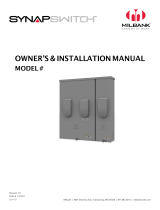
5
WARNING
Generator produces hazardous voltage.
Failure to properly ground generator could result
in electrocution.
Failure to isolate generator from utility power could result
in death or serious injury to electric utility workers due to
backfeed of electrical energy.
• DO NOT touch bare wires or bare receptacles.
• DO NOT use generator with electrical cords which are
worn, frayed, bare or otherwise damaged.
• DO NOT handle generator or electrical cords while
standing in water, while barefoot, or while hands or
feet are wet.
• If you must work around a unit while it is operating,
stand on an insulated dry surface to reduce the risk of
a shock hazard.
• DO NOT allow unqualified persons or children to
operate or service generator.
• In case of an accident caused by electrical shock,
immediately shut down the source of electrical
power and contact the local authorities. Avoid direct
contact with the victim.
• Despite the safe design of the generator, operating
this equipment imprudently, neglecting its
maintenance or being careless could cause possible
injury or death.
• Remain alert at all times while working on this
equipment. Never work on the equipment when you
are physically or mentally fatigued.
• Before performing any maintenance on the generator,
disconnect the battery cable indicated by a
NEGATIVE, NEG or (-) first. When finished, reconnect
that cable last.
• After your system is installed, the generator may
crank and start without warning any time there is a
power failure. To prevent possible injury, always set the
generator’s system switch to OFF, remove the service
disconnect from the disconnect box AND remove the
15 Amp fuse BEFORE working on the equipment.
WARNING
Propane and Natural Gas are extremely
flammable and explosive, which could cause
burns, fire or explosion resulting in death or
serious injury.
• Install the fuel supply system according to NFPA 37
and other applicable fuel-gas codes.
• Before placing the generator into service, the fuel
system lines must be properly purged and leak tested.
• After the generator is installed, you should inspect the
fuel system periodically.
• NO leakage is permitted.
• DO NOT operate engine if smell of fuel is present or
other explosive conditions exist.
• DO NOT smoke around the generator. Wipe up any
oil spills immediately. Ensure that no combustible
materials are left in the generator compartment. Keep
the area near the generator clean and free of debris.
WARNING
Exhaust heat/gases could ignite
combustibles or structures resulting in death
or serious injury.
Contact with muffler area could cause burns
resulting in serious injury.
• DO NOT touch hot parts and AVOID hot exhaust
gases.
• Allow equipment to cool before touching.
• Exhaust outlet side of weatherproof enclosure must
have at least 5 ft. (1.5m) minimum clearance from any
structure, shrubs, trees or any kind of vegetation.
• Standby generator weatherproof enclosure must be
at least 5 ft. (1.5m) from windows, doors, any wall
opening, shrubs or vegetation over 12 inches (30.5
cm) in height.
• Standby generator weatherproof enclosure must have
a minimum of 5 ft. (1.5 m) overhead clearance from
any structure, overhang, or trees.
• DO NOT place weatherproof enclosure under a deck
or other type of structure that may confine airflow.
• Use only flexible fuel line provided. Connect provided
fuel line to generator. DO NOT use with or substitute
any other flexible fuel line.
• Smoke detector(s) MUST be installed and maintained
indoors according to the manufacturer’s instructions/
recommendations. Carbon monoxide alarms cannot
detect smoke.
• Keep at least minimum distances shown in General
Location Guidelines to insure for proper generator
cooling and maintenance clearances.
• Replacement parts must be the same and installed in
the same position as the original parts.
WARNING
Hazardous Voltage - Contact with power lines
could cause electric shock or burns, resulting in
death or serious injury.Lifting Hazard / Heavy Object
- Could result in serious injury.
• If lifting or hoisting equipment is used, DO NOT
contact any power lines.
• DO NOT lift or move generator without assistance.
• DO NOT lift unit by roof as damage to generator
will occur.




















